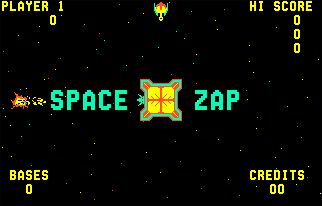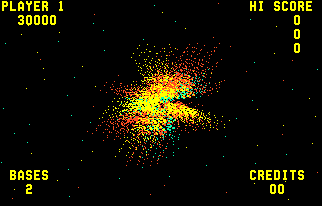 The Game: Players are manning the defenses of a space station under a constant onslaught from all sides by alien attackers. The station’s laser cannons can take out the alien ships and intercept their incoming fire; when an entire wave of attackers is eliminated, a much more mobile fighter will attack, and destroying it will advance the game to the next level of difficulty. (Midway,1980)
The Game: Players are manning the defenses of a space station under a constant onslaught from all sides by alien attackers. The station’s laser cannons can take out the alien ships and intercept their incoming fire; when an entire wave of attackers is eliminated, a much more mobile fighter will attack, and destroying it will advance the game to the next level of difficulty. (Midway,1980)
Memories: Space Zap is a game about helplessness. The player can’t move his space station one inch. It’s only possible to sit, shoot, and maybe sneak in a prayer here and there. Making matters more complicated is the fact that aiming controls and firing controls are separate; if Space Zap simply allowed the player to pick a direction and automatically fire, it’d be almost too easy. As it is, that’s certainly not the case.
 Space Zap made it home in an almost pixel-perfect translation on the Bally Professional Arcade system, which shared much of the graphics and sound hardware as Midway‘s 1970s arcade games. Despite the fact that Bally owned Midway at the time and could have easily titled the home version Space Zap, the game was instead titled Space Fortress – and with the Bally Arcade’s controllers, it gained a slightly more intuitive control system. But in virtually every other respect, it looked and sounded identical to its arcade counterpart.
Space Zap made it home in an almost pixel-perfect translation on the Bally Professional Arcade system, which shared much of the graphics and sound hardware as Midway‘s 1970s arcade games. Despite the fact that Bally owned Midway at the time and could have easily titled the home version Space Zap, the game was instead titled Space Fortress – and with the Bally Arcade’s controllers, it gained a slightly more intuitive control system. But in virtually every other respect, it looked and sounded identical to its arcade counterpart.
Somewhat surprisingly, Space Zap wasn’t followed by a raft of imitators on other consoles; on the Atari 2600, the closest thing to a Space Zap homage was the “meteor storm” screens of Imagic’s Cosmic Ark. Even though Space Zap looks like a stock Midway game, using the same graphics and sound hardware as most Midway fare built on the back of the Dave Nutting/Jamie Fenton-developed platform going back to Gun Fight, this game was actually developed by an outside company and licensed to Midway. Game-a-Tron was a company that seemed to specialize in developing games on existing hardware (they also devised new games based on Namco/Midway’s Galaxian hardware, among others). This practice of building new games on the foundation of existing hardware wasn’t exclusive to Game-a-Tron; countless  knock-offs started that way, but so did the relatively stellar 1980s success story of General Computer Corporation, who created Ms. Pac-Man as – originally – an unauthorized “enhancement kit.”
knock-offs started that way, but so did the relatively stellar 1980s success story of General Computer Corporation, who created Ms. Pac-Man as – originally – an unauthorized “enhancement kit.”